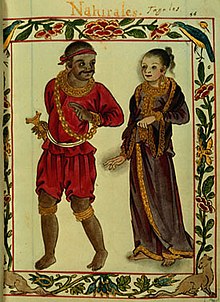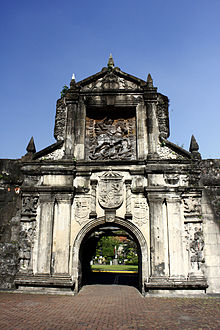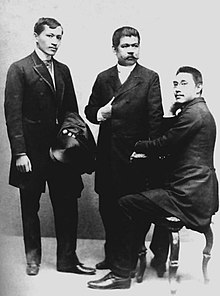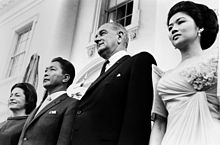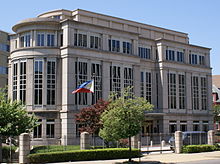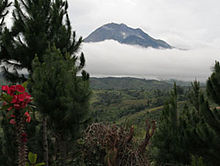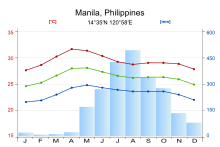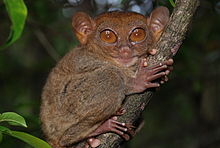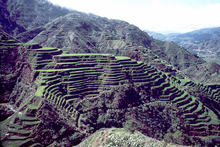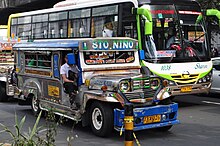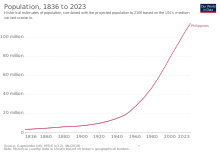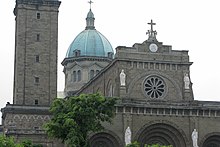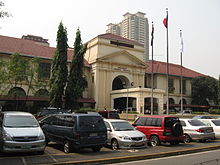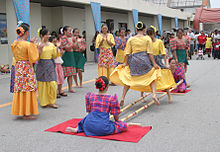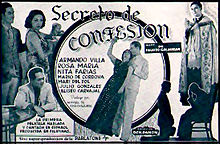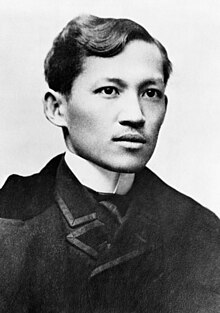Philippines
Philippines —officially, the Republic of the Philippines (in Tagalog, Republika ng Pilipinas; in English, Republic of the Philippines)— is an island country (see archipelago) located in Southeast Asia, on the Pacific Ocean. Its capital is Manila and its most populous city is Quezon City. To the north it is separated from the island of Taiwan by the Luzon Strait; to the west is the South China Sea, also known as the West Philippine and Vietnam Seas; to the southwest, the island of Borneo; to the south, the Celebes Sea separates it from other Indonesian islands, and to the east it borders the Philippine Sea. Its location in the Pacific ring of fire and its tropical climate make it prone to earthquakes and typhoons. The country is rich in natural resources and is located in one of the most biodiverse areas in the world. It is made up of 7,641 islands that are geographically classified into three groups: the island of Luzon, the group of Visayas and the island of Mindanao.
The Philippines has an estimated population of 109 million according to the 2020 census; In addition, it is the 12th most populous country in the world without taking into account the 12 million Filipinos living abroad. Several ethnic groups and cultures coexist throughout its islands. Listed as a newly industrialized country, its economy continues the constant growth that began since its independence. The economic reforms implemented at the beginning of the XXI century made The services sector will displace agriculture as the main economic activity, and now it contributes more than half of the GDP. However, it still faces various infrastructure challenges: the lack of development in the tourism sector, education, attention to health and human development.
In prehistoric times, the Negritos were some of the earliest inhabitants of the archipelago, followed by successive waves of Austronesian peoples who brought with them traditions and customs from Malaysia, India and the Islamic world, while trade introduced some Chinese cultural aspects These established the first island kingdoms ruled by Datus, Rajas or Sultans.
In 1521, the arrival of the explorer Ferdinand Magellan, a Portuguese in the service of Spain, ushered in an era of Spanish influence and later rule. Miguel López de Legazpi established the first Spanish settlement in the Philippines in 1565, with the Cebu Foundation. In 1571 he founded the city of Manila, which would become the administrative and economic center of the Spanish Empire in Asia and port of departure for the Manila galleon bound for Acapulco. The Philippines was ruled by the Mexico-centered Viceroyalty of New Spain before the direct government was decreed after the independence of Mexico. Three centuries of Spanish influence gave rise to a Hispano-Asian culture, evident in the art, music, gastronomy and customs of the Philippines, especially its Catholic religion. A Filipino variant of the Spanish language also emerged, flourishing in the second half of the 19th century and early XX.
At the end of the 19th century broke out the Philippine Revolution, supported by the United States, and later the Spanish-American War that led to the cession of the islands by Spain to the US in 1898. Disagreements between the new Philippine Republic and the US led to the Philippine-American War which ended with US victory in 1903. Thus, The United States replaced Spain as the dominant power. Except for the period of Japanese occupation, the Americans maintained sovereignty over the islands until the end of World War II in 1946. Since independence, the country has experienced several political crises that served to define the characteristics of a constitutional republic.
The legacy of the different historical periods is reflected in the current culture of the country, which is a combination of pre-Hispanic indigenous with Chinese elements and Hispanic culture, due to three centuries of Spanish presence. This mestizo culture is present in Filipino cuisine, music, dance and art. The Hispanic character is most evident in its Catholic religion, in its architectural legacy, especially the colonial-style churches and houses, in many of the country's place names and in first and last names. Finally, the United States' heritage lives on in the English language and in a greater affinity with popular culture.
Etymology
Before acquiring its current name, other names were used to refer to the country such as "Islas del Poniente" and "San Lázaro", both granted by Fernando de Magallanes. The word "Philippines" derives from the name of King Philip II of Spain. During an expedition in 1542, the Spanish explorer Ruy López de Villalobos named the islands of Leyte and Sámar "Felipines" in honor of the then Prince of Asturias. Finally, the name was altered and the name "The Philippine Islands" came to refer to all the islands of the archipelago. The official name of the Philippines has changed several times over the course of its history. During the Philippine Revolution, the Malolos Congress proclaimed the establishment of the "Philippine Republic." With American colonization and the introduction of the English language, the official name of the country was translated into the new predominant language, Republic of the Philippines. In this way, since its independence, the official name has been the "Republic of the Philippines", without putting the "las" before it, which results from the literal translation of the name.
History
Prehistory and pre-Hispanic times
Until recently, the oldest human remains found in the Philippine archipelago were thought to be from Tabon Man — dating from 22,000 to 24,000 years old — but they were replaced by the metatarsal of Callao Man, which according to the uranium–thorium method is 67,000 years old. The Negritos were among the first inhabitants of the islands, but the date of their appearance is still unknown. During the year 13,000 B.C. Austroasiatic settlement occurred, when they roamed the sunken landmass of Sundaland, of which the Philippines is a post-Flood island remnant, as detected in the genes of the Manobo and Sama peoples. Concurrent with this was the westward expansion of the Papuan race as detected in the genetics of Blaan and Sangil. Around 3000 BC. After the ice caps melted, Austronesian sailors, who make up the majority of today's population, migrated south from Taiwan. Around the year 1 AD. until pre-colonial times there was also limited immigration from South Asia, as found in the DNA of the Dilaut ethnic group. By 1000 BC. C., the inhabitants of the archipelago had organized themselves into four types of social groups: hunter-gatherer tribes, warrior societies, small plutocracies, and principalities centered on seaports.
Over the next few centuries, trade with maritime peoples and other Asian countries brought with it the influence of Islam, Buddhism, and Hinduism. During this time there was no unifying political state encompassing the entire Philippine archipelago. Instead, the islands were divided among several often warring thalassocracies, ruled by various datus, rajahs, or sultans. Among them were the kingdoms of Manila, Namayan and Tondó; politias of Cainta, Ma-i, Sandao, and Pulilu; Kedatuans from Dapitan and Madja-as; the Rajanates of Cebu, Butuan, and Sanmalan; and the sultanates of Lanao, Maguindanao, and Sulu. Some of these societies were part of the Malay empires of Srivijaya, Madjapahit, and Brunei. Islam reached the Philippines through traders and some proselytizers from Malaysia and Indonesia. Thus, in the 15th century Islam established itself in the Sulu Archipelago, and there is evidence that by 1656 it had already reached Mindanao, Luzon, and the Visayas. The Philippine kingdoms were divided and sparsely populated. This was due to constant warfare between kingdoms and the common frequency of natural disasters. Some Filipinos (Luzones) traded, settled, and fought in South, Southeast, and East Asia.
Spanish domination
In 1521, the Portuguese explorer Ferdinand Magellan arrived in the Philippines and took possession of the islands for Spain. The conquest began in 1565, when the Spanish explorer Miguel López de Legazpi arrived from New Spain and founded the first Spanish settlement in present-day Cebu. In 1571, after dealing with the native royal families during the Tondó conspiracy and defeating the crew of the Chinese pirate Limahong, the Spanish established Manila as the capital of the Philippines and the Spanish East Indies.
Spanish rule meant the political unity of the archipelago for the first time in its history. From 1565 to 1821 the Captaincy General of the Philippines depended on the Viceroyalty of New Spain based in Mexico City and after the Mexican War of Independence, it was administered directly from Madrid. From this same Captaincy, Spain controlled other of its territories in the Pacific, including Guam, Palau, the Caroline Islands and the Mariana Islands. Between the centuries XVI and XIX, the Manila galleon connected the capital of the Philippines with Acapulco, Mexico; making one or two trips a year in both directions. Due to the constant wars that produced little profit, the Philippines was subsidized by silver extracted from Potosí in Bolivia and Peru. Trans-Pacific trade introduced foods such as corn, tomatoes, potatoes, chili peppers, and pineapples to the archipelago, all from the Americas. Catholic missionaries converted most of the inhabitants to Christianity and founded schools, universities, and hospitals. The Spanish also brought the plow, the printing press, the clock and stone construction to the Philippines. An 1863 Spanish decree established free public education in the country for the first time, which led to high literacy rates.
During the period of Spanish rule, Hispanic forces and loyal Indians fought against several internal rebellions and multiple external attacks by Chinese, Dutch and Portuguese pirates: the Battles of Cagayan (1582) are especially noteworthy, which pitted the famous Spanish Tercios against Japanese pirates and ronins. In an extension of the fighting in the Seven Years' War, British forces briefly occupied the city of Manila after a heavy battle. British forces found allies such as Diego and Gabriela Silang, who seized the opportunity to lead a revolt, until Spanish rule was finally restored after the 1763 Treaty of Paris. During the occupation, the British took the opportunity to steal valuable letters Pacific navigation chart from the Manila archives.[citation needed] The Spanish who once waged a war against the Muslims in the homeland, known as the Reconquista, divided the pagan and Muslim Filipinos with each other. The Spanish extended the war against Islam in Europe at the Reconquista, to Islam in the Philippines. The Spanish-Moorish conflict lasted for several hundred years. In the last quarter of the 19th century, Spain conquered portions of Mindanao and the Moorish Muslims in the Sulu Sultanate, formally recognized as the Spanish sovereignty.
In the 19th century, Philippine ports opened up to world trade and changes occurred in Philippine society. At the beginning of the century the influence of the South American independence movements began to be felt. On February 1, 1818, Hipólito Bouchard, privateer of the United Provinces of South America, arrived aboard the frigate La Argentina. For two months he blocked Manila Bay, also closing the San Bernardino Strait.In this period, a number of Spaniards born in the Philippines (criollos) and those of mixed ancestry (mestizos) became wealthy. The influx of Spanish and Spanish-American settlers diminished the power of the Church and opened up some government posts traditionally held by Iberian-born Spaniards (peninsulares). Inspired by the Latin American wars of independence, there was an uprising by the short-lived Emperor Andrés Novales, supported by demoted Latin American officers of the Spanish-speaking Philippine army, who had opposed the inequality imposed by the peninsulares. The ideals of the revolution also began to spread. spread across the islands. Criollo dissatisfaction resulted in the Cavite El Viejo revolt of 1872, one of the precursors of the Philippine Revolution.
Philippine Revolution, First Philippine Republic and American rule
Revolutionary sentiments intensified in 1872, when three priests, Mariano Gómez, José Burgos, and Jacinto Zamora—known as Gomburza—were accused of sedition and executed by imperial authorities. This inspired a propaganda movement in Spain organized by Marcelo H. del Pilar, José Rizal and Mariano Ponce, who pressured the government to introduce political reforms in the Philippines. Rizal was finally arrested and, accused of rebellion, executed on December 30, 1896. As attempts to achieve these reforms met with great resistance, in 1892, Andrés Bonifacio founded a secret society called the Katipunan, related to groups of Freemasons who sought independence from Spanish rule through armed revolt. Bonifacio and the Katipunan began the Philippine Revolution in 1896. One faction of the Katipunan, the Magdalo of Cavite Province, came to challenge Bonifacio's position as leader of the revolution and Emilio Aguinaldo relieved him.
In 1898, the Spanish-American War began in Cuba and later spread to the Philippine archipelago already engulfed in revolt. On June 12, 1898, Aguinaldo declared Philippine independence from Spain in Kawit, Cavite, and the First Philippine Republic was established the following year. For its part, when Spain lost the war, it signed the Treaty of Paris in 1898, in which it ceded control of the islands to the United States for 20 million dollars. As it became increasingly evident that the United States would not recognize the First Philippine Republic, the Philippine-American War broke out.
The war ended in 1902 with a victory for the United States and between 200,000 and 1,000,000 died, mostly from famine and disease. Most modern historians put the death toll of the war at between 200,000 and 250,000, including a cholera epidemic at the end of the war that killed between 150,000 and 200,000 people.
In 1903, U.S. authorities counted the population of the Philippines for the census. The survey returned 7,635,426 people, including 56,138 foreign-born. In 1887, a Spanish census recorded a population of 5,984,717 excluding non-Christians.
By losing the conflict, the archipelago ended up under total US control, since until then it had been administered as an insular area; In 1935, the Philippines gained Commonwealth status under the name of the Philippine Commonwealth.
In the following decade, plans to regain independence were interrupted by World War II, particularly when the Japanese Empire invaded the country and established a puppet government, the Second Philippine Republic. During the conflict, multiple war crimes were committed, such as the Batán Death March and the Manila Massacre, which culminated in the Battle of Manila. The crimes against the population of Spanish origin and the assaults on the official Spanish headquarters in The Philippines caused great concern in the government of Francisco Franco. As a consequence, Spain severed diplomatic relations with Japan on April 12, 1945. By the time Allied troops defeated the Japanese in 1945, more than a million Filipinos had died. Finally, on July 4, 1946, the Philippines achieved its independence from the US government.
Marcos Dictatorship and Third Philippine Republic
After achieving its independence, the young nation faced several problems: the country had to be rebuilt from the ravages of war and reach an agreement with various collaborators and Japanese businessmen to begin its economic development. In rural areas, large landowners had their farms cultivated by tenants with miserable living conditions. They took a sizeable portion of the crops—usually half—and often became creditors to these heavily indebted farmers. Disputes between owners and farmers are frequent, and the authorities always support the owners. The political class was made up of men often compromised with the Japanese—beginning with Manuel Roxas who was elected president in April 1946. On the contrary, the deputies of the resistance to the Japanese occupation were prohibited from sitting in Congress to secure the majority necessary to pass, in the summer of 1946, a constitutional amendment necessary to implement a law favorable to American economic interests.
Primarily between 1948 and 1954, the communist-inspired Hukbalahap peasant uprising fought against the Philippine government and the militias of the big landowners. The Philippine government called in specialized counterinsurgency units, which spread terror among rural civilian populations suspected of sympathizing with the rebellion. With US military aid the government was able to weaken the movement, which had disappeared in the 1960s.
In 1965, Ferdinand Marcos was elected president, with his wife Imelda Marcos at his side. As the Constitution prohibited being re-elected more than twice for the presidential office, at the end of his second term he declared martial law on September 21, 1972. In order to continue ruling by decree, he used as arguments the political division, the tension of the War Cold and the specter of the communist rebellion and the Islamic insurgency in the country. In this way, a dictatorship began that lasted more than ten years and was characterized by strict control of the economy and political repression.
On August 21, 1983, Benigno "Ninoy" Aquino, Jr., a leader of the opposition to the Marcos government, ignored warnings and returned from exile in the United States. He was assassinated when his plane landed at Manila International Airport — now called Ninoy Aquino International Airport, in his memory. As political pressure increased, Marcos called a presidential election in 1986. Corazon Aquino, Benigno's widow, became the leader of the opposition and a candidate for the presidential race. When Marcos was declared the winner, many thought that the elections had been rigged. This led to the EDSA Revolution, instigated when two of Marcos's oldest allies—Fidel V. Ramos, Deputy Chief of Staff of the Armed Forces, and Juan Ponce Enrile, Secretary of National Defense—resigned and demonstrated in the Aguinaldo field and Crame field. The Cardinal Archbishop of Manila, Jaime Sin, urged people to rally in support of the rebel leaders and to protest at Avenida Epifanio de los Santos (EDSA). Faced with massive protests and military defections, Marcos and his allies fled to Hawaii, where they were exiled. That same year, Corazon Aquino was named president.
The return of democracy and government reforms after the events of 1986 were hampered by national debt, corruption, coup attempts, a persistent communist insurgency, and Islamic separatist movements. Although the economy improved during the administration of Fidel V. Ramos, who was elected president in 1992, the onset of the 1997 Asian financial crisis halted these advances. In 2001, amid allegations of corruption and a deadlocked impeachment process, Ramos's successor, Joseph Estrada, was ousted from the presidency by the 2001 EDSA Revolution and replaced by Gloria Macapagal-Arroyo.
The nine years of Arroyo's government were characterized by economic growth, but these were marred by corruption and political scandals. On November 23, 2009, 34 journalists and several civilians were killed in Maguindanao. In the 2010 presidential election, Benigno "Noynoy" Aquino III and Jejomar Binay were elected to the post of president and vice president respectively. Economic growth it continued during the Aquino administration, who pushed for better governance and transparency. In November 2013 Typhoon Haiyan devastated the central part of the archipelago, affecting more than eleven million Filipinos and causing the deaths of more than five thousand people; the press criticized the slow response by the Aquino III government. In 2015, a clash in Mamasapano, Maguindanao killed 44 members of the Philippine National Police Special Action Force, leading efforts to pass the Bangsamoro Basic Law to a standstill.
Former Davao City Mayor Rodrigo Duterte won the 2016 presidential election, becoming the first president of Mindanao. Duterte launched an anti-drug campaign and infrastructure program. The implementation of the Bangsamoro Organic Law led to the creation of the Bangsamoro Autonomous Region in Mindanao. In early 2020, the COVID-19 pandemic hit to the country causing the gross domestic product to fall by 9.5%, the worst annual economic result for the country since records began in 1947.
In the 2022 presidential election, the son of Ferdinand Marcos, known as Bongbong Marcos, won the presidential election, thereby bringing the country's foreign policy closer to China. In response to his critics, Bongbong has said that he will try to assert the "maritime territorial rights" of the Philippines under his leadership despite seeking a rapprochement with China.
Government and politics
The Philippines is a constitutional republic with a presidential system of government, administered as a unitary state, with the exception of the Autonomous Region of the Moorish Nation in Muslim Mindanao, which is largely independent of the national government. The president acts as head of state and head of government, as well as being the commander-in-chief of the armed forces. He is elected by popular vote for a single six-year term, during which he chooses and presides over his own cabinet.The Vice President is also elected by direct suffrage for a six-year term, and may be re-elected once. The vice president can hold a cabinet position, and in the event the president dies or resigns, he would become the acting president and call an election. At the local level, the executive power is represented by the governors of the provinces, the mayors of the cities and municipalities, and by the captains of the barangay.
The bicameral Congress is made up of the Senate —equivalent to the upper house, with members elected for a six-year term— and the House of Representatives —the lower house, with members elected for a three-year term. Senators are elected at the same time as the president, while representatives are elected through legislative districts and through proportional representation. Congress is responsible for the creation and approval of laws and amendments to the constitution through resolutions and projects Of law. For any bill to pass it must receive more than two-thirds of the votes in favor in both chambers.
The judiciary is headed by the Supreme Court, composed of the Chief Justice as the presiding judge and fourteen associate judges, who are chosen by the president from among various candidates proposed by the Council of Justice and the Bar Association. The judiciary enjoys fiscal autonomy, although it is supervised by the Office of the Court Administrator. The Supreme Court also promulgates the regulations for all courts and participates in the process of teaching future lawyers. Since the administration of the Ramos government, there have been several attempts to reform the government to a federal, unicameral, or parliamentary system.
The legal system established by the 1987 Constitution contains elements inherited from the time of Spanish and US rule. For example, those questions about property, family and the absence of a jury in trials are characteristic of continental law, existing in Spain. However, the Anglo-Saxon law installed by the United States at the beginning of the XX century is the one that governs some of the most important legal issues. important. Among these, trade, labor relations, taxes, banking and currency stand out.
The Philippine multi-party system allows for the existence of numerous political parties, although in practice it is common for alliances to be created to obtain more votes during electoral contests. For its part, the Elections Commission (Comelec) defined six parties as the most important in the country: the Liberal Party, the Lakas Kampi CMD, the Nationalist Party, the Popular Nationalist Coalition, the National Union Party and the United Alliance. Nationalist. Since 1992, national and local elections have been held every three years on the second Monday in May. Only elections for president and vice president are held every six years. The minimum voting age is 18 years. In the presidential elections held in 2010, just over 38 million voters participated, 74.34% of those registered on the electoral roll.
Although homosexuality is not illegal in the Philippines, there is some discrimination by society in general towards this group. Until 2009 homosexuals were prohibited from enlisting in the armed forces. Although multiple efforts have been made in the fight for the rights of the LGBT community, same-sex marriage is still illegal and there is no recognition for legal unions made in other countries.
Foreign Relations
The international relations of the Philippines are based on trade with other nations and the welfare of the eleven million Filipinos living outside the country. As a founder and active member of the United Nations, he has been elected several times to integrate the Security Council of the UN, and a national, Carlos P. Rómulo, was President of the General Assembly of the United Nations. The country is an active participant in the Human Rights Council, as well as in peacekeeping missions, notably in East Timor.
In addition to its participation in the UN, the country is one of the founders and active member of the Association of Southeast Asian Nations (ASEAN), an organization designed to strengthen relations and promote economic and cultural growth among states of the Southeast Asian region. It has hosted several of its summits and is an active contributor to the bloc's leadership and policies. The relations it currently enjoys with other Southeast Asian states are in stark contrast to the situation in the bloc. 1970s, when it was at war with Vietnam and the territory of Sabah was disputed with Malaysia, although there are still disagreements regarding the Spratly Islands.
It is also a member of the East Asia Summit (EAS), the Asia-Pacific Economic Cooperation (APEC) Forum, the Latin Union, the Group of 24, the Non-Aligned Movement and is considered an important ally extra-NATO. It also seeks to strengthen its relations with Islamic countries through its candidacy to enter the Organization of the Islamic Conference as an observer.
On the other hand, it has good relations with the United States, which it supported during the Cold War and the War on Terror. However, in recent years the US presence at the Subic and Clark Bay military bases and the Agreement of Visiting Forces have generated some controversy. Japan, the country's largest official contributor of development aid, is also considered one of its main allies. Although certain historical debates still prevail between the two countries—especially on issues such as comfort women—much of the enmity raised by the events of World War II have disappeared.
The Philippines has also established good relations with other nations. The fact of sharing various democratic values facilitates their relations with European and Western countries. The economic problems it is going through help it create links with other developing countries that are facing similar obstacles. Similarly, historical ties and cultural similarities deepen relations with Spain and Spanish America. Despite problems affecting overseas Filipino workers, such as domestic abuse and war, as well as obstacles posed by a Islamic insurgency in Mindanao, relations with countries in the Middle East—including Egypt, Iran, Iraq, Libya, Saudi Arabia, and the United Arab Emirates—are good, allowing the more than two million Filipinos to continue living and working in the region. For its part, relations with the People's Republic of China have improved considerably, especially since the 1950s. However, various issues related to the recognition of the Republic of China, the possession of the Spratly Islands and concerns about the growth of Chinese influence, prevent a close relationship between the two neighbors. Recently, Philippine foreign policy has been moving towards mainly to establish better economic relations with its neighbors in Southeast Asia and the Pacific.
In 2016, a ruling by the Permanent Court of Arbitration located in The Hague recognized the Masinloc shoal and other disputed islands as Philippine. China therefore offers the Philippines to ignore the ruling in exchange for joint oil and gas drilling.
Armed Forces
Defense is provided by the Armed Forces of the Philippines, which is made up of three corps: the Air Force, the Army, and the Navy (including the Marine Corps). In 2010, the armed forces had more than 331,500 active members, the 40th largest in the world. For its part, the Philippine National Police is in charge of civil security, under the command of the Department of the Interior and local governments.
In the Autonomous Region of Muslim Mindanao, the most important separatist organization, the Moro National Liberation Front, is the political ruler of the region. Other militant groups such as the Moro Islamic Liberation Front, the communist New People's Army and the Abu Sayyaf are still fighting in other provinces, but their presence has been reduced in recent years, thanks to government-implemented security operations.
It is also worth noting that the Philippines has been an ally of the United States since World War II: in 1951, the two countries signed a mutual defense treaty. The Philippines supported American ideology during the Cold War, as well as its involvement in the Korean and Vietnam wars. He was even a member of the dissolved SEATO, an organization whose objective was to carry out a role similar to NATO in the region, whose members included Australia, France, New Zealand, Pakistan, Thailand, the United Kingdom, and the United States. At the start of the War on Terror, the Philippine Army was part of the coalition that supported the US in Iraq, making it an important non-NATO ally.
Human Rights
In terms of human rights, regarding membership of the seven bodies of the International Bill of Human Rights, which include the Human Rights Committee (HRC), the Philippines has signed or ratified:
Territorial organization
The Philippine archipelago is divided into three island groups: Luzon, Visayas, and Mindanao. These are further divided into 17 regions, 80 provinces, 138 cities, 1,496 municipalities and 42,025 barangays. Additionally, section 2 of the Republic Act No. 5446 states that the definition of the territorial sea around the territory Filipino, has no effect on the claim on Sabah. The regions of the Philippines are listed below, the number that appears in the table is used to locate them on the map to the right.
| N.o | Region | Designation | Regional centre |
|---|---|---|---|
| 1 | Ilocos | Region I | San Fernando |
| 2 | Administrative Region of La Cordillera | CAR | Baguio |
| 3 | Cagayán Valley | Region II | Tuguegarao |
| 4 | Central light | Region III | San Fernando |
| 5 | Region of the National Capital | NCR | Manila |
| 6 | Calabarzón | Region IV-A | Calambá |
| 7 | Mimaropa | Region IV-B | Calapanán |
| 8 | Bicoland | Region V | Legazpi |
| 9 | Eastern Bisayas | Region VIII | Tacloban |
| 10 | West Banks | Region VI | Iloílo |
| 11 | Central bisayas | Region VII | Cebu |
| 12 | Zamboanga Peninsula | Region IX | Pagadian |
| 13 | Northern Mindanao | Region X | Cagayán de Oro |
| 14 | Caraga | Region XIII | Butuan |
| 15 | Autonomous Region of the Moran Nation in Muslim Mindanao | BARMM | Cotabato |
| 16 | Dávao | Region XI | Dávao |
| 17 | Soccsksargen | Region XII | Koronadal |
Geography
The Philippines is an archipelago of 7,107 islands, with a total area of approximately 300,000 km²—including inland bodies of water. Its 36,289 km of coastline make it the fifth country with the longest coastline in the world. The Philippine territory is located between the coordinates 116°40′E, 126°34′E and 4°40′N, 21°10′N. It is bordered by the Philippine Sea to the east, the South China Sea (or West Philippine Sea) to the west, and the Celebes Sea to the south. The island of Borneo lies just a few hundred kilometers to the southwest, and the island of Taiwan lies directly to the north. The Moluccas and Sulawesi lie in the southwest and Palau is located to the east of the islands.
Most of the islands are mountainous, covered in dense rainforest, and volcanic in origin. The highest mountain is Mount Apo, with an altitude of 2954 m s. no. m. and is located on the island of Mindanao. The Galathea Depression in the Philippine Trench is the lowest point in the national territory, and the third deepest in the world, located on the bottom of the Philippine Sea. Likewise, the longest river is the Cagayan, in the north of Luzon. Manila Bay, where the city of the same name is located, is connected to the Bay Lagoon—the largest lake in the Philippines—by the Pasig River. The most important river basins in the country are the Pulangi and Agusan river basins in Mindanao and the Cagayan and Pampanga river basins in Luzon. Subic Bay, Davao Gulf and Moro Gulf are other important bays. The San Juanico Strait separates the islands of Samar and Leyte, although they are connected by the San Juanico Bridge.
Located on the western periphery of the Pacific Ring of Fire, the territory experiences frequent seismic and volcanic activity. The Benham Plateau, to the east in the Philippine Sea, is a submarine region with very high tectonic subduction activity. About 20 earthquakes are recorded daily, although most are too weak to feel; the last major earthquake on record was the 1990 Luzon earthquake. Similarly, there are many active volcanoes in the archipelago, including Mount Mayon, Mount Pinatubo, and Taal Volcano. The eruption of Mount Pinatubo in June 1991 produced the largest land eruption of the XX century. However, not all Notable landforms have such a violent or destructive origin: an example of the legacy of geological activity is the Puerto Princesa Subterranean River.
Mineral deposits are abundant due to the volcanic nature of the islands. The Philippines is estimated to have the second largest gold deposit after South Africa and one of the largest copper deposits in the world. The subsoil is also rich in zinc, chromium, and nickel. Despite this, mismanagement, high population density, and environmental awareness have left these largely untapped. Unlike the above, geothermal energy is one of the products of volcanic activity that the country has taken advantage of more successfully. The Philippines is the second largest producer of geothermal energy in the world, behind the United States, as it covers 18% of the national electricity demand.
To the south of the Philippines passes the Wallace line, the biogeographic boundary that separates the regions of Asia and Oceania through Insulindia. The fauna, and to a lesser extent the flora, are distinct on each side, despite geographic proximity and relative climatic similarity, reflecting separate evolutionary histories. The line runs between the islands of Bali and Lombok, east of Java; it continues between the island of Borneo, which it leaves to the west, and the Celebes and passes to the south of the Philippines.
Climate
The Philippines has a tropical maritime climate that is usually hot and humid. Three seasons are distinguished: tag-init or tag-araw, the hot dry season from March to May; tag-ulan, the rainy season from June to November; and tag-lamig, the dry temperate season from December to February. The southwest monsoon from May to October is known as the Habagat and the dry winds of the northeast monsoon from November to April are known as the Amihan. temperatures normally range between 21 °C to 32 °C, although they can be colder or warmer depending on the season; the warmest month is January and the warmest is May.
The average annual temperature is around 26.6 °C. When examining temperatures, location in terms of latitude and longitude is not an important factor. Whether in the far north, south, east, or west of the country, temperatures at sea level tend to be in the same range. Generally, it is the altitude that has the most impact. The average annual temperature of Baguio, located at an elevation of 1500 m s. no. m., is 18.3 °C, which makes it a popular destination during hot summers.
Being located in a tropical cyclone zone, most of the islands experience torrential rains and thunderstorms from July to October, due to an average of nineteen cyclones entering Philippine territory, and eight to nine of them they make landfall on the archipelago. Mean annual precipitation is up to 5,000 mm on the mountainous section of the east coast, but less than 1,000 mm in some of the lower valleys. Rainiest tropical cyclone to impact the country was the July 1911 typhoon, which dumped more than 1,168 mm of rain in just 24 hours on the city of Baguio. Since then, the term bagyo has been used in Tagalog to refer to a tropical cyclone.
Flora and fauna
The jungles and long coastlines are home to a wide range of birds, plants, animals and marine creatures. The Philippines is one of the ten most biologically diverse countries, with one of the highest rates of biodiversity per unit of surface — up to 1,736 species per 100 km² — about 1,100 species of terrestrial vertebrates can be found, including more than 100 species of mammals and 170 species of birds that are not believed to exist elsewhere. Endemic species include the Mindoro tamarao, Visayan spotted deer, Philippine mouse-deer, Visayan warthog, Philippine flying lemur, and several species of bats.
However, it lacks any large predators, with the exception of snakes, such as pythons and cobras, and some birds of prey, such as the Philippine Monk Eagle, the national bird. Other native animals include the palm civet, the dugong and the Philippine tarsier. With an estimated 13,500 plant species in the country—3,200 of which are unique to the islands—the Philippine jungles boast abundant flora, including many rare types of orchids and rafflesias. Narra is considered the hardwood most important in the national industry. Thanks to its tropical climate, flowering plants are abundant and are used as ornaments, for the manufacture of perfumes and as food. Among these stand out the ylang-ylang and the sampaguita, the national flower. Other notable plant specimens include the 54 species of bamboo that exist throughout the archipelago; the coconut palms, which are the basis of the economy of many localities; nipa, mahogany and mabolo trees, whose wood is exploited for construction; the fruits of the pili nut, the durian and the lansons; and the carnivorous plants known as monkey cups.
The country's marine waters cover nearly 2.2 million km² and are home to unique and diverse marine life, which is an important part of the Coral Triangle. 2,400 species of fish and more than 500 species of coral live here. The Apo Reef is the largest contiguous coral reef system in the country and the second largest in the world. Philippine waters also support the cultivation of pearls, crabs, and algae.
Deforestation, often the result of illegal logging, is a serious problem in the Philippines. Forest cover declined from 70% of the country's total area in 1900 to 18.3% in 1999. Many species are threatened with extinction, and scientists say Southeast Asia, of which the Philippines is a part, faces a catastrophic extinction rate of 20% by the end of the XX century. According to Conservation International, "the country is one of the few nations that is, in its entirety, a hotspot and a country of megadiversity, which places it among the highest priority areas for global conservation."
Economy
The Philippine economy is among the fifty most powerful economies in the world, with nominal GDP estimated at US$348 billion for 2017. Major exports are semiconductors and electronics, transportation equipment, clothing, consumer goods, copper, petroleum products, coconut oil, and fruits. Likewise, its main trading partners are the United States, Japan, China, Singapore, South Korea, the Netherlands, Hong Kong, Germany, Taiwan, and Thailand. Its currency is the Philippine peso (₱ or PHP). The Philippines is a member of the World Bank, the International Monetary Fund, the World Trade Organization (WTO), the Asian Development Bank (which is based in the city of Mandaluyong), the Plan Colombo and the G-77, among other groups and institutions.
As a newly industrialized country, the Philippine economy shifted from being based on agriculture to focusing on services and manufacturing. Of the 38.1 million people that make up the country's labor force, the agricultural sector employs about 45.2%, but contributes only 13.8% of GDP. The industrial sector employs around 15.2% of the active population and represents 30% of GDP. For their part, 39.6% of workers are in the service sector, which is responsible for 56.2% of GDP. In October 2013, the unemployment rate rose to around 6.5% and due to the global economic slowdown, in December of the same year inflation reached a level of 4.1%. In February 2010, gross international reserves were 45,713 million dollars. In 2004, public debt as percentage of GDP was estimated at 74.2%; in 2008, it fell to 56.9%, while the gross external debt increased to 66,270 million dollars. In July 2011, the inflation rate was at a level of 5.1%, showing an increase of more than one percentage point in relation to the same month of 2010.
After World War II, it was considered the second richest economy in East Asia, behind only Japan. However, during the 1960s it began to be surpassed. The economy stagnated under the dictatorship of Ferdinand Marcos, due to political instability and economic mismanagement by the regime. The country suffered slow economic growth and periods of recession. It was not until the 1990s that the economy began to recover, due, according to various analysts, to a program of economic liberalization.
In 1997, the Asian financial crisis affected its economy, resulting in a continued devaluation of the national currency and several stock market crashes. However, its effects on the Philippines were not as severe as on some of its Asian neighbors. This happened in large part because of the government's fiscal conservatism, a result of decades of fiscal monitoring and oversight by the International Monetary Fund (IMF), compared to its neighbors' massive spending for rapidly accelerating their economic growth. Since then, the Philippines has shown signs of progress. In 2004, the economy experienced growth of 6.4% of GDP and 7.1% in 2007, its fastest growth rate in three decades. However, the average annual growth of GDP per capita for the period 1966–2007 was 1.45% compared to the average of 5.96% for East Asia and the Pacific overall, plus the daily income of 22.6% of the Filipino population is still less than 1, $25. Despite enjoying stable economic growth through the first decade of the XXI century, by 2010, the economy of the country was smaller than that of its Southeast Asian neighbors—Indonesia, Thailand, Malaysia, and Singapore—in terms of GDP and nominal GDP per capita.
There are other imbalances and challenges in the Philippines. The economy is heavily dependent on remittances, which outstrip foreign direct investment as a source of foreign exchange. Regional development is uneven, with Luzon—particularly Metro Manila—accounting for much of the economic growth at the expense of other regions, although the government has taken steps to spread economic growth by promoting investment in other areas. from the country. Despite the limitations, services such as tourism and Business Process Outsourcing have been identified as some of the best areas of opportunity for growth in the country. Goldman Sachs included the country in its list of the "Next Eleven" economies, although China and India have emerged as its main economic competitors in the region.
Tourism
Thanks to its geographical conditions and the existing biodiversity in the archipelago, the Philippines has multiple natural parks that serve as its main tourist attraction. The tourism industry began to develop in the 1970s. However, due to the existing conflicts in the country, it was not until the end of the following decade that tourism began to form an important part of local economic development. Since then, Tourism is constantly growing, and it is estimated that by 2016 it will generate more than 7.4 million jobs, 18.8% of the labor force, and will contribute between 8 and 9% of the national GDP.
In 2012, 4,272,811 foreign tourists visited the Philippines, almost 10% more than the previous year. Most of these came from South Korea (24.1%), the United States (15.2%), Japan (9.6%), China (5.8%) and Taiwan (5%). the main tourist destinations are: Manila, mainly the old part of the city; Boracay, named the best island in the world by Travel + Leisure magazine, Coron Island, famous for shipwrecks World War II warfare and diving; the Puerto Princesa Subterranean River, declared one of the seven wonders of nature; the rice terraces of the Philippine Cordilleras, declared a World Heritage Site by UNESCO; Vigan, another World Heritage Site characterized by its colonial architecture; the festivals of the cities of Cebu and Davao, among many others.
Infrastructure
Energy
Many analysts say that thanks to its geographical location, the Philippines has enormous potential for energy resources. However, most of the renewable energy sources remain unused due to the lack of economic resources and infrastructure for their use. For example, it is estimated that the country could produce 35,000 MW if it used all the geothermal potential that exists in its territory. In 2010, of the 51,300 million kWh of electrical energy that was consumed in the country, 66.1% it came from fossil fuels, 21.1% from hydroelectric plants and only 12.8% from other renewable energy sources. There are no nuclear power plants in the Philippines.
In the 1970s the government authorized the search for oil fields in the area of Sulu and Palawan, and by 1979 commercial exploitation of the discovered fields began. In 2010 it produced about 26,640 barrels of oil per day, along with 2.86 billion m³ of natural gas. Additionally, Philippine soils are rich in minerals such as: copper, chromium, gold, and nickel, and there are small deposits of cadmium, iron, lead, manganese, mercury, molybdenum, and silver.
Transportation
Transportation infrastructure is relatively underdeveloped. This is partly due to the islands' mountainous terrain and sparse geography, but it is also the result of little government investment. In 2003, only 3.6% of GDP was allocated to infrastructure development, a percentage that was significantly lower than that of some of its neighbors. Consequently, although there are 203,025 km of roads, only around 20% of the Total is paved.
There are many ways to get around, especially in urban areas. Buses, jeepneys, taxis, and motorized three-wheelers are available in major cities. In 2007 there were approximately 5.53 million registered motor vehicles, with an average annual increase of 4.55%. There are also three railway networks that serve to communicate the different areas of Greater Manila and other parts of Luzon: the Metro Manila (LRT), the Greater Manila Railroad Transit System (MRT) and the Philippine National Railways (PNR).
Because it is an archipelago, it is often necessary to make inter-island trips by boat. The busiest ports are those of Iloílo, Manila, Cebu, Davao, Cagayan de Oro, and Zamboanga. Passenger ships and other vessels, such as those operated by Superferry, Negros Navigation, and Sulpicio Lines, connect Manila with various cities and towns. In 2003, the Autopista Náutica Fuerte de la República (SRNH) was established, a set of highway segments and ferry routes that cover 919 km and connect 17 cities. Some rivers that pass through metropolitan areas, such as the Pasig and Marikina rivers, have ferry service for passengers. This service on the Pasig River has numerous stops in Manila, Makati, Mandaluyong, Pasig and Marikina. There are another 3,219 km of waterways in the interior of the country.
There are 85 public airports in the country, and around 111 more that are private. Ninoy Aquino International Airport (NAIA) is the main international airport. Other major airports include Diosdado Macapagal International Airport, Mactan-Cebu International Airport, Francisco Bangoy International Airport, and Zamboanga International Airport. Philippine Airlines, Asia's oldest commercial airline still operating under its original name, and Cebu Pacific, the leading low-cost carrier, are the country's leading airlines and those serving the largest number of domestic and international destinations.
Media
The Philippines has a sophisticated mobile phone industry and a high concentration of users. As of 2008, there were about 67.9 million mobile phone subscribers in the country. Text messaging is a popular form of communication and has fostered a culture of quick hellos and forwarded jokes among Filipinos. In 2007, the nation sent an average of one billion SMS messages per day. Apart from this growing number of text message users, more than five million use their phone as a virtual wallet, making the country a leader among nations. developing in the provision of financial services through mobile phone networks.
The Philippine Long Distance Telephone Company, known as PLDT, is the leading telecommunications provider and the country's largest carrier. Its subsidiaries, Smart Communications and Piltel, along with the Ayala group's Globe Telecom, BayanTel and Sun Cellular are the most important mobile phone service providers in the national territory.
There are approximately 398 AM and 837 FM radio stations, 87 broadcast television channels, and 1,804 cable television channels. Estimates for Internet penetration in the Philippines vary widely, from a low of 5.1 million to a high than 24 million people. Social media and video websites are among the most visited by Filipino users.
Filipino media outlets mainly use the Philippine language and English for their broadcasts. Some also use other local languages, especially on the radio, due to their ability to reach the most remote rural populations, who would otherwise have no other means of communication. The dominant television networks, ABS-CBN and GMA Network, also have extensive radio presence.
Some daily newspapers in the Philippines include Manila Bulletin, The Daily Tribune, Cebu Daily News, among others.
The entertainment industry is very active, feeding newspapers and tabloids an endless supply of details about celebrities and tabloid scandals. As in other countries, drama and fantasy series are surpassed by Hispanic telenovelas, asianovelas and anime. Daytime television is dominated by talk shows—such as Eat Bulaga, Showtime and Happy, Yipee, Yehey—, variety shows and contests.
Demographics
The first official census was conducted in 1877 and recorded a population of 5,567,685. As of 2010, the Philippines became the 12th most populous nation in the world, with a population of over 92 million. The population growth rate between 1995 and 2000 was 3.21%, and decreased to 1.95% for the period 2005-2010; however, this rate is still a matter of debate. The median age of the population is 22.7 years, and 60.9% of Filipinos are between the ages of 15 and 64. Life expectancy at birth is 71.38 years old; 74.45 for women and 68.45 years for men.
There are about 11 million Filipinos living abroad. Since the liberalization of immigration laws in the United States in 1965, the number of people in the United States with Filipino ancestry has grown significantly: by 2007, there were between 3 and 4 million Filipino Americans. According to the United States Census Bureau, immigrants from the Philippines make up the second largest group of people seeking family reunification, after only Mexican immigrants. About two million of Filipinos work in the Middle East; almost half of them are in Saudi Arabia, and there is also a significant migratory flow to Spain, a country where Filipino emigrants can acquire nationality by residing for two years thanks to the existing dual nationality treaties between the two countries.
According to 2010 data, 49% of the population lived in cities. Large cities are made up of several localities called barangays, which comprise several "sites" or neighborhoods. Six out of ten Filipinos live in a barangay, which generally has a school, one or two supermarkets, and a chapel or Catholic church. The growing urban population has created a clash between the traditionalist values of the inhabitants of rural areas and the new customs of daily life. The urbanization rate is 2.3%. This rapid rate of urbanization is the reason why many of the immigrants live in houses built with materials that are not very resistant, such as cardboard and sheets, without basic services such as electricity, drinking water and drainage.
Ethnic groups
As of the 2000 census, 28.1% of Filipinos are Tagalog, 13.1% Cebuano, 9% Ilocano, 7.6% Visayan/Binayo, 7.5% Hiligainon, 6 % Bícoles, 3.4% Samareños, and the remaining 25.3% are classified as "other." This general classification can be broken down to show more tribal groups such as the Moro, Pampango, Pangasinense, Ibanag, and ivatan. There are also several indigenous peoples, such as the Igorotes, the Lumad, the Mangyan, the Bajau, and the Palawan tribes. The Negritos, such as the Aeta and Ati, are considered among the first inhabitants of the islands.
Filipinos generally belong to various Asian ethnic groups classified linguistically as part of the Austronesian and Malayo-Polynesian language families. It is believed that aboriginal people from Taiwan migrated to the Philippines thousands of years ago bringing with them knowledge of the agriculture and ocean sailing, leading to the displacement of the first groups of negritos from the islands. The Manobo and Sama ethnic groups have an ancestral affinity with the Austroasiatic Mlabri and Htin peoples of mainland Southeast Asia. South Asian ancestry was also detected among Filipinos and peaked among the Dilaut people. A westward expansion of Papuan ancestry from Papua New Guinea to eastern Indonesia and Mindanao was also detected among the Blaan and Sangir.
Ultimately, Chinese, Spanish, Latin American, Indian, and American colonists procreated the various ethnic groups that had developed on the islands. Their descendants are known as mestizos, of whom Chinese Filipinos are the most numerous, with two million pure Chinese people and Chinese-Filipino mestizos make up 20% of the population. According to a survey of cemetery samples, European Filipinos (mainly Spanish) make up 6% of the Filipino population. Ibero-Americans and their mixtures, on the other hand, make up 12.7% of the population. Other migrant ethnic groups that have settled in the country include Arabs, British, other Europeans, Indonesians, Japanese, Koreans, and other South Asians.
Languages
| Native languages (2000) | |
|---|---|
| Hold it. | 22 million |
| Cebuano | 20 million |
| Ilocano | 7.7 million |
| Hiligainón | 7 million |
| Pampango | 3.1 million |
Ethnologue lists 175 different languages in the Philippines, 171 of which are living languages, while four no longer have any known speakers. All are part of the Malayo-Polynesian language group of Borneo-Philippines, which is itself a branch of the Austronesian language family, with the sole exception of Chavacano, which is a creole language based on Mexican Spanish.
Under the 1987 Philippine Constitution, Filipino and English are the official languages. Filipino is a standard de facto version of Tagalog, spoken in Metro Manila and other urban regions. Filipino and English are used in government, education, politics, the media, printing, and business. The Constitution designates regional languages, such as Central Bicolano, Cebuano, Ilocano, Hiligainon, Pampango, Pangasinense, Tagalog, and Samareño, as auxiliary official languages. It also stipulates that Spanish and Arabic must be promoted on a voluntary and optional basis. There are also other dialects that have regional relevance and validity.
There are currently around 4,000 Spanish speakers in the Philippines, which is 0.5% of the total population. However, the Instituto Cervantes de Manila details that for economic reasons related to globalization, interest in studying this language is increasing. Likewise, the headquarters of said institute in the Philippine capital is one of the ones with the most students.
Spanish was used to draft the Aguinaldo Declaration of Independence, the Malolos Constitution of the first Philippine republic in 1899, and the first lyrics of the national anthem. José Rizal also developed all of his work in the Spanish language, Cebuano, Tagalog among other native languages, maintain their influence from Spanish.
Religion
More than 90% of the population is Christian: 80% belong to the Catholic Church, while 10% belong to other Christian denominations, such as the Philippine Independent Church, the Seventh-day Adventist Church, the Iglesia ni Cristo, the Church of Jesus Christ of Latter-day Saints, the United Church of Christ, Jehovah's Witnesses, and the Orthodox Church. The Philippines is one of two Asian countries where Catholics are in the majority, the other being East Timor.
Between 5 and 10% of the population is Muslim, living mostly in the Mindanao, Palawan and Sulu regions, an area known as Bangsamoro or the "land of the Moors". Some of them have migrated to urban and rural areas in different parts of the country. Most Muslim Filipinos practice Sunniism according to the Shafi'i school.
Many indigenous and tribal groups still practice various traditional religions, often syncretized with Christianity and Islam. Animism and shamanism are still present as currents of other traditional religions, through albularyo, babaylan and manghihilot. Traditional Chinese religions, Buddhism and Taoism, are predominant in Chinese communities. The country also has a significant number of Baha'i followers.
Education
In 2008, the National Statistics Office reported a simple literacy rate of 93.4% and a functional literacy rate of 86.4%. The values are similar for men and women. Spending on education it is around 2.5% of GDP. According to the department of education (DepEd), in 2010 there were 44,846 primary schools and 10,384 registered secondary schools, while the Commission on Higher Education (CHED) listed 1,741 higher education institutions, 203 of which were public and 1,538 private. Classes begin in June and end in March, but most universities follow a semester calendar, from June to October and from November to March. In addition to the above, there are several foreign schools with their own curricula. Republic Act No. 9155 provides the legal framework for basic education in the Philippines, defining primary and secondary education as compulsory and free.
Several government agencies are involved in education. The Department of Education covers primary, secondary and informal education; the Technical Education and Skills Development Authority (TESDA) administers post-secondary training and intermediate level education; and the Higher Education Commission (CHED) supervises universities and postgraduate academic programs, in addition to regulating the standards for the delivery of higher education. In 2004, madrasahs were incorporated in 16 regions throughout the country, mainly in the areas Muslim universities in Mindanao, under the auspices and program of the Department of Education. Public universities are non-sectoral entities and are classified as State Colleges and Universities (CUE) and Local Colleges and Universities (CUL). CUEs are funded by the National Government, as determined by Congress. The University of the Philippines is the largest and most important national university in the Philippines.
Health
Most of the country's health services are provided by private health institutions. In 2010, total health expenditures represented 3.6% of GDP. 65.3% came from private companies, while 34.7% was from government institutions and 1.3% from external resources. The same year, health expenditures accounted for about 6.7% of total government spending, while per capita spending was $63. The proposed national health budget for 2010 was 28 billion pesos (more than 597 million dollars), that is, ₱ 310 (US$ 7) per person. The government's share to cover total health spending has steadily decreased, in addition to the fact that with the increase in population, spending per capita is also reduced.
In the Philippines there are about 90,370 doctors -1 for every 833 people-, 480,910 nurses, 43,220 dentists and 1 hospital bed for every 769 people. Retention of qualified professionals is a problem, since 70 % of nursing graduates go abroad to work, resulting in the country being the largest provider of nurses in the world. In 2012 there were some 1,800 hospitals throughout the country, of which around 40% were state and the other 60% private. Cardiovascular diseases are the cause of more than 25% of deaths. According to official estimates, between January and August 2012, 2,156 new cases of infection with the human immunodeficiency virus (HIV) were registered, of which 116 developed acquired immunodeficiency syndrome (AIDS). Since records began in 1984, 353 people have died from this disease in Philippine hospitals.
Main towns
Greater Manila, also known as the National Capital Region, comprises the city of Manila itself, 15 other nearby cities, and a municipality. Ten of its component cities are among the twenty most populous in the country. With an estimated population of more than 11 million, Metro Manila ranks among the most populous urban agglomerations in the world. The population of its metropolitan area, which includes parts of other neighboring provinces, exceeds 20 million. Davao in Mindanao and Cebu in the Visayas are other major urban areas. The table below shows the twenty most populous cities in the Philippines.
Culture
Filipino culture is a combination of Eastern and Western culture. The Philippines presents aspects found in other Asian countries with a Malay heritage; however, its culture also shows a great deal of Spanish and American influences. Thus, traditional festivals known as barrio fiestas are common for commemorate the feast day of a saint, at the same time that festivals such as Moriones and Sinulog are celebrated. These community celebrations are accompanied by banquets, music and dance. Some traditions, however, are gradually changing or being forgotten due to modernization.
One of the most visible Hispanic legacies is the prevalence of Spanish-origin first and last names among Filipinos. However, the name does not necessarily denote Spanish ancestry. This peculiarity, unique among the peoples of Asia, came as a result of a government decree, the Edict of Clavería, for the systematic distribution of family names and the application of the Spanish naming system. The names of many streets, cities and provinces they are also in Spanish, plus all the languages spoken in the Philippines have hundreds of Hispanic loanwords.
The common use of the English language is an example of the American impact on Philippine society. It has contributed to the full acceptance and influence of American popular culture trends. This affinity is manifested in Filipinos' taste for American fast food, movies, and music. Fast food outlets are found on major street corners. Although major international fast food chains have entered the market, local fast food chains such as Goldilocks and most notably Jollibee, the leading fast food chain in the country, have emerged and are successfully competing against their foreign rivals.
Art
Before the arrival of the Europeans, each ethnic group developed and refined its own artistic manifestations, influenced by Malay, Chinese and Islamic art. However, it was during the Spanish conquest that missionaries introduced Western techniques for the practice of various arts. In this way, once the Filipinos converted to Christianity, they stopped sculpting small idol figures to dedicate themselves to the elaboration of altarpieces, reliefs and sculptures of saints of the Catholic Church. After the century XIX the works of sculpture were directed towards other non-religious expressions; the works known as Country Guys—sculptures showing people of various Filipino ethnicities performing tasks of their daily lives—became the most popular.
Similar to sculpture, early Philippine paintings are religious in nature, since the teaching of this art was for church use only. Towards the end of this period, European influence gained strength and developed Philippine classicism. American domination opened the doors to modernist trends in painting, which have enriched the nation's pictorial heritage. The Philippine National Folk Dance Company Bayanihan has been recognized for its attempt to preserve many of the traditional dances practiced throughout Philippines. His interpretations of iconic Filipino dances have become famous, especially in dances such as the tinikling and singkil, characterized by the use of bamboo poles to represent confrontations.
Filipino music can be classified into three broad groups: folk music, Spanish-influenced music, and contemporary music. Folk music encompasses all the traditions that endure among the country's indigenous groups. The main musical instruments used are the gong, the xylophone, the flutes, trunk drums, the harp, bamboo zithers, among others. Music influenced by the Spanish is mostly religious, although secular forms combined folkloric elements with Hispanic music for the creation of various traditional songs. The main legacy of this style is the rondallas and the Filipino adaptation of the Spanish estudiantinas. Finally, contemporary music is strongly linked to American trends, their lifestyle and their popular culture. The so-called pinoy pop is a Filipino genre that encompasses various Western styles such as rock, jazz, hip-hop, disco and pop with the country's folkloric traditions.
The National Commission for Culture and the Arts (NCCA), created in 1987 by President Corazón Aquino, is the body in charge of creating, promoting, coordinating, and regulating all cultural and artistic programs, policies, and activities. The Order of National Artists is the highest recognition awarded by the NCCA to those artists who make significant contributions to the development and promotion of Philippine arts. As of 2013, only 57 people have received such a designation in fields that span architecture, film, visual arts, literature, fashion design, dance, historical literature, music, and theater.
Architecture
The architecture of the Philippines is characterized by a strong Spanish influence and the integration of multiple elements of the native Filipino culture. In fact, according to local folklore, typical Filipino houses must meet certain architectural characteristics to ensure good luck and prosperity for the family that inhabits them. For example, the ideal house should receive the sun's rays in the morning on two of its facades. Stairs must face east, must not be located in the center of the building or have a number of steps that is a multiple of three. Other considerations include not placing two doors facing each other, not building basements, placing the bed away from the door, and making the dining room the largest and lightest space in the house.
Spanish architecture left its mark in the Philippines in the layout of many cities that were designed around a central plaza, but many of the buildings with its architectural influence were demolished during World War II. Some architectural examples that continue standing are mainly churches, government buildings and universities. In fact, the Unesco World Heritage List includes four Filipino baroque churches of Spanish construction: the Church of San Agustín de Manila, the Church of San Agustín de Paoay, the Church of Nuestra Señora de la Asunción and the Church of Santo Tomás de Villanueva. Vigan, in Ilocos Sur, is also recognized for the many Hispanic-style houses and buildings that still remain.
After American rule and World War II, Philippine architecture began to adapt modern Western architectural trends, which combined with local traditions and culminated in the creation of the "Filipino style," present in buildings such as the headquarters of the House of Representatives and the houses of government housing programs. United Architects of the Philippines (UAP) is an organization created in 1974 with the purpose of regulating and organizing all certified architects in the country and supporting and promoting their works to national and international level.
Cinema
Cinema in the Philippines began with the introduction of the first film on January 1, 1897, at the Pertierra Hall in Manila. The following year, the Spanish Antonio Ramos made the first filming with the Lumière brothers' cinematograph. The first film made by a Filipino was Dalagang Bukid (Country Maiden), a film based on a popular musical, directed by José Nepomuceno. Known as the "father of Philippine cinematography", his work marked the start of cinema as an art form on the islands. The Philippines was the last country to establish a national film library, which opened in October 2011.
Even with the problems currently facing cinema, movies are still considered one of the most popular forms of entertainment among Filipinos. The film industry employs more than 260,000 people and generates around ₱2 billion annually. Some of the most successful Philippine films include: Kailangan Kita (2002), Libingan (2007), Ang Lihim ni Antonio (2008), Bata Bata Paano Ka Ginawa? (1998), Ang Pagdadalaga ni Maximo Oliveros (2005), Moral (1982), Mababangong Bangungot (1979), Tinimbang Ka Ngunit Kulang (1974), Kisapmata (1981) and Oro Plata Mata (1982). Among the most critically acclaimed directors and actors of Filipino origin are Lino Brocka and Nora Aunor, for films such as Maynila: Sa mga Kuko ng Liwanag and Himala. In recent years, it has become common to see Filipino celebrities transition between television and film and then political activism.
Mythology and Literature
Filipino mythology has been transmitted primarily through the popular literature and oral tradition of the Filipino people. While each ethnic group has its own unique stories and myths, Hindu and Spanish influence can be detected in many cases. Many of the myths are creation stories or about supernatural creatures, such as the aswang (vampire), diwata (fairies) and nature. Some popular figures from Philippine mythology are Tikbalang, Maria Makiling, Lam-Ang, and the Sarimanok.
Filipino literature comprises works generally written in Filipino, Spanish, and English. Some of the best-known Philippine works were created in the 19th century. Francisco Balagtas, poet and playwright who wrote Florante at Laura, is recognized as a prominent writer of the Philippine language. José Rizal wrote the novels Noli Me Tangere and El Filibusterismo , where he represented the injustices of Spanish rule. His death by firing squad inspired other Filipino revolutionaries to seek independence and he is considered a national hero. In the 20th century, Filipino writers officially recognized as national artists of the Philippines include: N.V.M. González, Nick Joaquín, F. Sionil José and Alejandro Roces.
Festivities
Each year, the Philippine Congress agrees on a calendar of holidays and non-business days to be celebrated throughout the country. In general, these festivals coincide with the anniversary of historical events or are religious celebrations. The main festivities observed in the Philippines are:
| Date | Holiday | Local name | Notes |
|---|---|---|---|
| 1 January | New Year | Araw ng Bagong Taon | Start of the Gregorian calendar. On 31 December, it is not laborable either. |
| 25 February | Anniversary of the EDSA Revolution | Anibersaryo ng Himagsikang Lakas ng Taumbayan | Beginning of the EDSA Revolution in 1986. |
| Variable | Holy Week | Holy Week | Non-working days correspond to Holy Thursday, Good Friday and the Sabbath of Glory. |
| 9 April | Batan Day | Araw ng Kagitingan | It commemorates the battle of Batan during the Second World War. |
| 1 May | Labour Day | Araw ng Paggawa | Commemoration of the international day of the workers. |
| 12 June | Independence Day | Araw ng Kalayaan | Declaration of the Philippine Independence of Spain. |
| 21 August | Ninoy Aquinas Day | Araw and Ninoy Aquinas | Anniversary of the murder of Ninoy Aquinas. |
| Variable | National Heroes Day | Pambasang Araw ng mga Bayani | Held last Monday of August. |
| 1 November | Day of All Saints | All Saints / Araw ng mga Patay / Araw ng mga Banal | Religious festival in honor of the dead. The 2nd of November is not laborable either. |
| 30 November | Bonifacio Day | Araw and Bonifacio | In honor of the birth of the revolutionary Andrés Bonifacio. |
| 25 December | Christmas | Pasko | On 24 December, it is not laborable either. |
| 30 December | José Rizal Day | Araw and Rizal | In honor of the death of José Rizal, poet and national hero. |
Gastronomy
Filipino cuisine has evolved over several centuries from its Malay-Polynesian origin to become a mixed cuisine with many Hispanic, Chinese, American and other Asian influences, which have been adapted to local ingredients and palates to create dishes clearly Filipinos. The range of dishes ranges from the simple, such as a meal of fried fish with salt and rice, to the highly elaborate, such as stews and paellas prepared for the holidays. Popular dishes include suckling pig, adobo, sinigang, kare kare, tapa, crispy leg, pancit, lumpia, halo- halo and puto. Some local ingredients commonly used in cooking are calamondins, coconuts, saba, mangoes, milkfish, and various fish. Filipinos tend to favor strong flavors, but their dishes are not as spicy as their neighbors. One of the most famous dishes is the Balut. This meal consists of a fertilized duck egg with its embryo inside, its preparation is the same as a boiled egg. In several Asian countries it is considered a delight since it provides high protein content. It is usually sold in street stalls.
Unlike many Asian countries, Filipinos do not eat with chopsticks, instead using Western cutlery. However, possibly due to the fact that rice broth is the main staple food and the popularity of a large number of stews and dishes made with rice, the main pair of utensils on the Philippine table is the spoon and fork, and not the knife and fork. The traditional way of eating with the hands, known as kamayan, is seen more often in sparsely urbanized areas.
Sports
There are several popular sports and pastimes in the country, most notably basketball, boxing, badminton, taekwondo, billiards, bowling, chess, and sipa. Extreme sports like motocross, cycling and mountaineering are also gaining popularity. Basketball is played at the amateur level and is considered the most popular sport in the country. In fact, almost every neighborhood in the city has a basketball court. The national team participated in various editions of the Olympic Games and the World Basketball Championship —where they won a bronze medal in 1954— and in multiple regional and local tournaments.
The Philippines has participated in the Olympic Games since 1924 and until the 2012 edition it won a total of nine medals: seven bronze and two silver. Of these, five come from boxing, two from swimming, and two from track and field. Some Filipinos recognized for their sporting achievements include Francisco Guilledo, Flash Elorde, and Manny Pacquiao in boxing; Paulino Alcántara in soccer; Carlos Loyzaga, Robert Jaworski and Ramón Fernández in basketball; Efren Reyes in billiards; Eugene Torre in chess; and Rafael Nepomuceno in bowling.
Children and young people in the country still play many of the traditional Filipino games, such as luksung baka, patintero, piko and tumbang prisoner. sungka and mahjong are two of the most popular board games in the country. Card games are mainly played during certain festivities, although some, including pusoy and tong-its, are used for illegal gambling. The yo-yo was introduced in its modern form by Pedro Flores, and its name comes from the Ilocano language.
Lastly, arnis / Eskrima / kali is officially the martial art and national sport of the Philippines. Cockfighting was already flourishing in the pre-Hispanic Philippines, as recorded by Antonio Pigafetta, Italian chronicler aboard Ferdinand Magellan's 1521 expedition.
Contenido relacionado
Christopher Columbus
Map conic projection
Swiss
